Explore Hitachi - Japan Travel, Asia
Welcome to Hitachi, a charming city nestled in Ibaraki Prefecture, Japan. Known for its stunning natural landscapes and rich cultural heritage, Hitachi is a hidden gem that offers a unique blend of modern convenience and traditional Japanese charm. This place is not just a city; it's a gateway to exploring Japan's less-traveled paths. From vibrant parks to serene shrines, the city invites you to experience the essence of Japanese life. Let’s uncover what makes Hitachi a fantastic destination for travelers seeking authenticity and adventure.
Population: Approximately 166,000 in 2024.
Economy: Hometown of the famous Hitachi group, the city is one of the most important industrial centers of Japan.
Landmarks: Famous for the Hitachi Seaside Park, Kamine Park, and Hitachi Castle Ruins (or Mito Castle).
Japan

Overview of Hitachi
History & Cultural Influence
Hitachi's history is deeply intertwined with its cultural landscape. The city's name, which translates to "sunlight," reflects its historical significance and its connection to the sun goddess Amaterasu, a central figure in Japanese Shinto belief. Founded in the early 20th century as an industrial hub, Hitachi has evolved into a vibrant city that celebrates its past while embracing the future. The city's cultural heritage is also evident in its festivals and traditional crafts. Hitachi’s local festivals, such as the Hitachi Festival, highlight traditional performances and rituals that have been preserved over generations. This cultural event offers guests a singular chance to see regional traditions and interact with the local populace.
Are you in love with Japanese culture? Discover the traditional area of Japan, Takayama, here.
Interaction with the Locals
Located in Ibaraki Prefecture, the city of Hitachi is home to over 166,000 people. The city's population is a mix of long-time locals and newcomers who contribute to its dynamic community. Hitachi's citizens are known for their warm hospitality and strong sense of tradition, creating a welcoming environment for visitors. The city's blend of modern amenities and historical charm reflects the diverse and vibrant nature of its population.

Hitachi during Cherry Blossom season - © Facts
Top Attractions in Hitachi
Hitachi offers a diverse array of attractions that highlight its natural beauty, historical significance, and cultural richness. These attractions offer rich experiences, from historical sites and natural wonders to cultural landmarks, making Hitachi a diverse and fascinating destination for all types of travelers.
- Hitachi Seaside Park: Famous for its seasonal flower displays, including the striking blue nemophila blooms in spring and vibrant red kochia bushes in autumn. The park's sprawling landscapes and colorful gardens provide a picturesque backdrop for leisurely strolls and family outings.
- Kamine Park: Known for its scenic views and historical sites, this park features lush greenery, walking trails, and a lookout point offering panoramic pictures of Hitachi and its surroundings. It offers a peaceful haven away from the bustle of the city.
- Hitachi City Historical and Folk Museum: Explore local history and culture through a rich collection of artifacts and exhibits. Important insights into Hitachi's historical and cultural heritage may be gained from this museum.
- Oarai Isosaki Shrine: An iconic coastal shrine with a striking torii gate that appears to float on the water. It’s a popular spot for both spiritual reflection and scenic photography.
- Hitachi Castle Ruins (Mito Castle): Although now a ruin, Hitachi Castle offers a glimpse into Japan’s feudal past. The site features remnants of the castle walls and moats, set amidst beautiful parkland.
- Gokoku Jinja Shrine: This shrine is renowned for its historical significance and beautiful architecture. It’s a peaceful place to experience traditional Japanese spirituality and customs.
- Fukuroda Falls: These breathtaking waterfalls, which are only a short drive from Hitachi, are ranked among the top three waterfalls in Japan. The falls cascade in multiple tiers, offering spectacular views throughout the year.
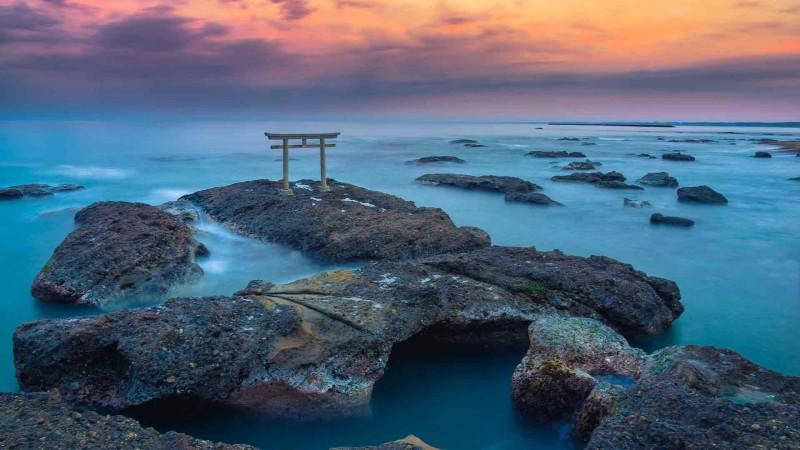
Oarai Isosaki Shrine - © byFood
Must-Try Dishes in Hitachi
When visiting Hitachi, indulging in the local cuisine is a must. The city’s iconic dishes are renowned for its fresh ingredients and traditional Japanese flavors. Exploring this delicious journey through local flavors and ingredients makes your visit a true culinary adventure.
- Hitachi Beef: Known for its rich flavor and tender texture, Hitachi beef is a local specialty that’s prized for its quality. Whether enjoyed as a steak, in a yakiniku (grilled meat) dish, or as part of a hot pot, this premium beef is a culinary delight.
- Fresh Seafood: Hitachi's coastal location ensures a bounty of fresh seafood. Try the sashimi or tempura made with locally caught fish and seafood. The region is especially known for its delicious squid and sea urchin dishes.
- Soba Noodles: These buckwheat noodles are a staple in Japanese cuisine. In Hitachi, they are often served chilled with a dipping sauce or in a hot broth with seasonal vegetables.
- Miso Soup: A comforting staple of Japanese cuisine, Hitachi’s miso soup is made with locally produced miso paste and often includes fresh tofu and seaweed.
- Oarai’s Seafood Rice Bowl: A local favorite, this dish features a generous serving of fresh seafood, including crab and fish, atop a bowl of steamed rice. It’s a satisfying and flavorful meal that captures the essence of Hitachi’s coastal cuisine.
- Seasonal Desserts: Don’t miss out on seasonal Japanese sweets, such as matcha (green tea) ice cream and daifuku (sweet rice cakes), which are often enjoyed as a refreshing end to a meal.
Wajima is a destination that is also famous for many desserts and distinctive cuisine, learn more about Wajima in this article.
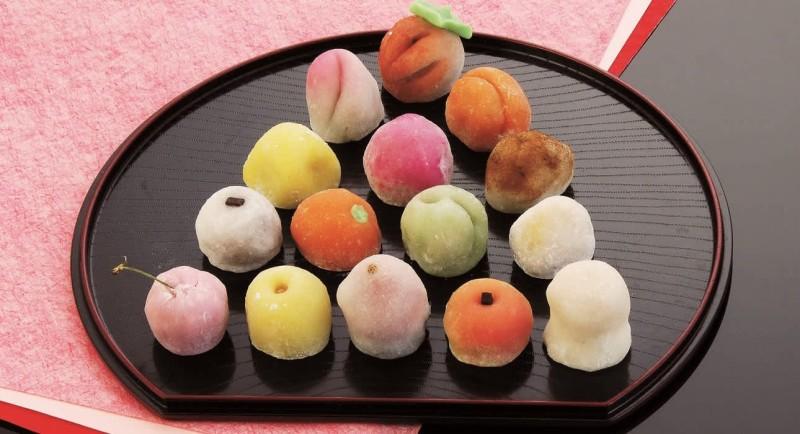
Japanese Daifuku - © Japan Tourism
Festivals & Local Celebrations
Hitachi’s festivals and local celebrations are vibrant expressions of Japanese culture. These events offer a rich tapestry of experiences, showcasing Hitachi’s cultural heritage, community spirit, and local traditions. Attending these events allows visitors to engage with the local culture and enjoy the vibrant atmosphere of Hitachi throughout the year.
Hitachi Festival
Held annually in July, the Hitachi Festival is a lively celebration that showcases traditional Japanese culture. The festival features a grand parade with beautifully decorated floats, vibrant performances of traditional dance and music, and various cultural activities. Participants often wear colorful yukata (summer kimonos), and the atmosphere is filled with excitement and festivity. The Hitachi Festival provides an excellent opportunity to witness local customs and engage with the community in a lively and celebratory setting.
Oarai Umi no Hi (Sea Day Festival)
Celebrated in early July, Oarai Umi no Hi is a festival dedicated to celebrating the sea and promoting marine conservation. Held in the nearby coastal town of Oarai, this festival features a range of beachside activities, including environmental awareness programs, beach cleanups, and educational exhibitions about marine life. Visitors can enjoy fireworks displays, beach games, and seafood stalls offering a taste of local delicacies. The festival emphasizes the importance of protecting the ocean while providing a fun and festive environment for all ages.
Hitachi Autumn Festival
Held in October, the Hitachi Autumn Festival is a celebration of the harvest season and Japanese cultural heritage. The festival features traditional music and dance performances, including taiko (Japanese drums) and folk dances. Local food stalls offer seasonal delicacies, and craft vendors display handmade goods. The festival’s lively atmosphere and cultural activities make it a great way to experience Hitachi’s vibrant community spirit and traditional customs during the autumn season.
Hitachi City Fireworks Festival
In August, the Hitachi City Fireworks Festival lights up the night sky with a spectacular display of fireworks. Held along the banks of the Nakagawa River, the festival features a dazzling array of colorful firework bursts and patterns. Visitors gather along the riverbanks for a festive evening, enjoying food stalls, traditional snacks, and the breathtaking fireworks display. The festival provides a festive and family-friendly atmosphere, making it a popular event for both locals and tourists.
Check out many festivals during the year in Kōchi, another dynamic region of Japan, here.
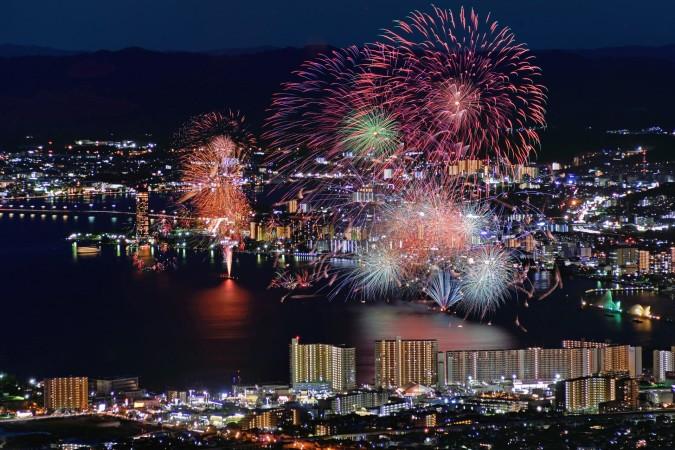
Hitachi City Fireworks Festival - © Japan Web Magazine
What to Do in Hitachi
Hitachi offers a range of activities that cater to various interests, from outdoor adventures to cultural experiences. These activities ensure a fulfilling visit to Hitachi, offering a mix of relaxation, adventure, and cultural exploration.
- Nature Walks and Hiking: Explore Hitachi’s natural beauty through its numerous parks and trails. The Hitachi Seaside Park and Kamine Park offer scenic walks and hiking opportunities amidst lush landscapes and panoramic views.
- Beach and Water Activities: Hitachi’s coastline is perfect for beachgoers. Enjoy swimming, sunbathing, and beach sports at local beaches. Water activities such as fishing and coastal boat tours are also popular.
- Cultural Workshops: Engage in traditional Japanese crafts and cultural experiences, such as pottery making, tea ceremonies, and kimono dressing. These workshops provide hands-on experiences and insights into Japanese culture.
- Local Markets and Shopping: Visit local markets and shopping districts to experience Hitachi’s vibrant commerce. Find locally grown vegetables, handmade crafts, and unique souvenirs.
- Relaxing Hot Springs: Nearby hot springs offer a relaxing retreat. Soak in natural thermal waters and enjoy a therapeutic experience that’s part of Japan’s rich tradition of onsen (hot spring baths).
Shopping in Hitachi
Shopping in Hitachi is an enjoyable experience, offering everything from local specialties and crafts to modern retail options. It’s a great way to take home a piece of Hitachi’s charm and culture.
- Local Markets: Explore bustling local markets where you can find fresh produce, artisanal goods, and traditional Japanese snacks. These markets provide an opportunity to engage with local merchants in a lively setting.
- Shopping Streets: Hitachi’s shopping streets feature a mix of shops selling clothing, accessories, and souvenirs. Look out for stores offering traditional crafts, such as pottery and textiles, which make for unique keepsakes.
- Hitachi Shopping Centers: For a more modern shopping experience, visit local malls and shopping centers. These venues offer a range of international and Japanese brands, dining options, and entertainment facilities.
- Traditional Craft Shops: Discover shops specializing in traditional Japanese crafts, including handmade ceramics, lacquerware, and textiles. These shops provide an opportunity to purchase high-quality, locally made items.

Japanese Tea Ceremony - © TGL
Weather in Hitachi: Best Time to Visit
Hitachi experiences a temperate climate with distinct seasons, each offering unique tourism trends and activities, providing diverse experiences throughout the year, and making it a year-round destination for travelers.
Spring in Hitachi
- Weather: Spring in Hitachi is characterized by mild temperatures ranging from 10°C to 20°C (50°F to 68°F) and the blooming of cherry blossoms.
- Tourism Trend: This is a peak season for cherry blossom viewing, especially in Kamine Park and along local streets. Visitors flock to witness the beautiful sakura (cherry blossoms), participate in hanami (flower viewing) picnics, and enjoy outdoor festivals. The pleasant weather makes it an ideal time for exploring parks and participating in local cultural events.
Summer in Hitachi
- Weather: Summers are warm and humid, with temperatures ranging from 20°C to 30°C (68°F to 86°F). July and August are especially hot and may include occasional thunderstorms.
- Tourism Trend: Summer is popular for beach activities and water sports along Hitachi’s coastline. Local festivals and fireworks events, such as the Hitachi City Fireworks Festival, attract visitors. Summertime brings a plethora of outdoor activities and vivid cultural festivals, despite the often oppressive heat.
Autumn in Hitachi
- Weather: Autumn brings cooler temperatures ranging from 15°C to 25°C (59°F to 77°F) and stunning fall foliage.
- Tourism Trend: Autumn is ideal for enjoying the beautiful fall colors in parks like Kamine Park and participating in seasonal festivals. The crisp, comfortable weather is perfect for hiking, nature walks, and exploring Hitachi’s natural beauty. It’s also a time for harvest festivals and cultural events that highlight local traditions and seasonal foods.
Winter in Hitachi
- Weather: Winters are chilly but often pleasant, with temperatures between 32°F to 50°F (0°C to 10°C) with little snow falls.
- Tourism Trend: Winter is a quieter time for tourism in Hitachi, but it offers a peaceful experience with fewer crowds. It’s a great time for enjoying local indoor attractions, relaxing hot springs, and winter festivals. A more peaceful visit would be perfect because of the peaceful ambiance created by the crisp air and sporadic frosts. Winter sales and seasonal events provide additional attractions for visitors.
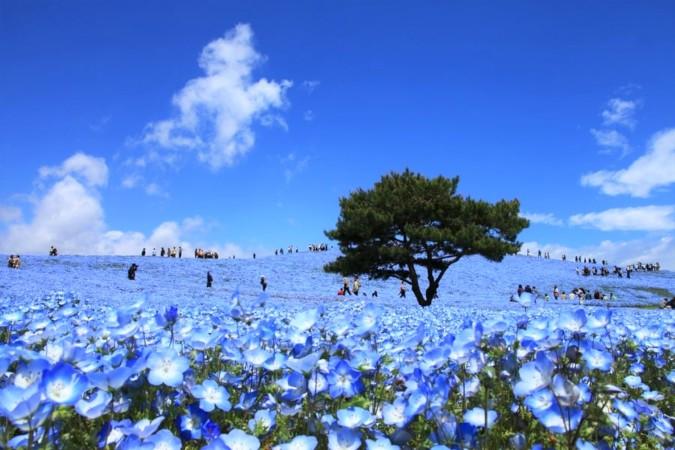
Spring in Hitachi marked by the blooming of Nemophila - © VnExpress
Culture Etiquette in Hitachi
Understanding and respecting local customs is essential when visiting Hitachi. The following are important cultural customs to remember:
- Greetings: In Japan, bowing is the customary way to welcome someone. A slight bow is sufficient and is often used in both formal and informal settings.
- Shoes: It is customary to remove your shoes when entering homes, certain traditional accommodations (like ryokan), and some temples or shrines. Be prepared to follow this practice and wear clean socks.
- Quiet and Respectful Behavior: Japanese culture values quiet and respectful behavior in public places. Avoid speaking loudly or making a fuss, especially in temples, shrines, and public transportation.
- Dining Etiquette: When dining, use chopsticks properly—avoid sticking them upright in rice, and never pass food directly from one set of chopsticks to another, as this mimics funeral rites.
- Gift Giving: If invited to someone’s home, it is polite to bring a small gift as a gesture of appreciation. Common gifts include local specialties or sweets.
Essential Travel Information
Getting Around Hitachi
Hitachi is well-connected and accessible through various transportation options:
- Train Line: The JR Hitachi Station is a major transportation hub, connecting Hitachi to other cities in Japan while the Joban Line provides convenient access to Tokyo and other regional destinations. For moving throughout the city, there are additional buses and local train services.
- Public Bus: Hitachi has a network of local and regional buses that make it easy to travel around the city and to nearby areas. Buses are a convenient option for reaching places not directly accessible by train.
- Car: Renting a car is a good option for exploring Hitachi and its surrounding areas at your own pace. Major roads and highways provide easy access to the city.
- Bicycle: Hitachi is bicycle-friendly, with many areas suitable for cycling. Renting a bicycle can be a pleasant way to explore local attractions and parks.
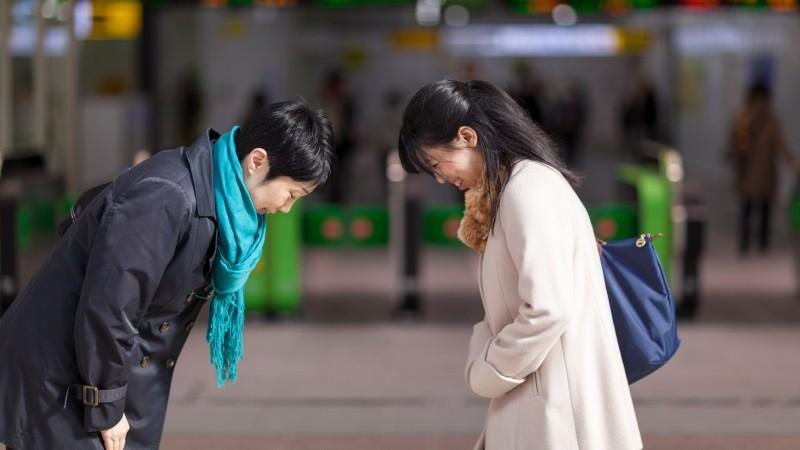
Being familiar with Japanese bowing culture - © National Geographic
ATM & Banking Services
Accessing banking services in Hitachi is convenient with numerous ATMs located throughout the city, including at convenience stores, banks, and major shopping centers. International credit and debit cards are widely accepted, though carrying some cash for smaller purchases is advisable. Several banks operate in the area with standard banking hours typically from Monday to Friday, 9:00 AM to 3:00 PM, and some offer English-speaking services. Currency exchange services can be found at major banks, airports, and certain hotels, so it's wise to exchange some currency before your trip or use ATMs for easy access to cash.
Where to Stay in Hitachi
Hitachi offers a range of accommodation options to suit different preferences and budgets. These options cater to various needs, ensuring a comfortable stay while you explore Hitachi and its surroundings.
- Hotels: There are various hotels in Hitachi, from luxury to budget options. Established chains and local hotels provide comfortable stays with amenities such as Wi-Fi, dining options, and convenient access to attractions.
- Ryokan: For a traditional Japanese experience, consider staying at a ryokan (Japanese inns). These inns offer a unique cultural experience with tatami mats, futon bedding, and traditional Japanese baths.
- Guesthouses: Budget travelers can opt for guesthouses or hostels, which provide affordable accommodation and a chance to meet fellow travelers. Some guesthouses offer private rooms as well.
- Capsule Hotels: For a distinctive and budget-friendly experience, capsule hotels offer small, private sleeping pods. They are a convenient and novel choice for solo travelers.
Articles for you

Explore Yala National Park - Sri Lanka Travel, Asia
Tucked away in Sri Lanka’s southeastern corner, Yala National Park is where wild nature meets deep tradition. Known worldwide for its leopard population, the park is also home to elephants, sloth bears, crocodiles, and hundreds of bird species. Beyond wildlife, Yala opens doors to a cultural landscape dotted with ancient temples, Buddhist ruins, and coastal villages. For travelers seeking more than just a safari, Yala offers a chance to explore eco-tourism, local communities, and sacred heritage sites.
Population: The Yala National Park area doesn’t have a human population.
Economy: The economy around Yala National Park thrives on a blend of eco-tourism, agriculture, and local services. Safari tours, eco-lodges, and cultural experiences drive steady income for nearby towns like Tissamaharama and Kataragama, supporting thousands of families.
Landmarks: Famous for Block I of Yala and wildlife encounters, including elephants, sloth bears, crocodiles, and exotic bird species.

Explore Galle - Sri Lanka Travel, Asia
Nestled on Sri Lanka’s southern coastline, Galle is a vibrant city where history meets the sea. Its cobbled streets, colonial architecture, and serene beaches make it a must-visit destination for travelers seeking a blend of culture, adventure, and relaxation. A UNESCO World Heritage site, Galle captivates visitors with its Dutch Fort, bustling markets, and friendly locals. Whether you’re exploring the ramparts at sunset or savoring fresh seafood by the shore, Galle promises an unforgettable journey into Sri Lanka’s heritage.
Population: Approximately 113,000 in 2023.
Economy: Galle’s economy thrives on tourism, trade, and fisheries. The city’s historic fort, colonial architecture, and coastal charm draw thousands of international visitors each year, making tourism its main economic driver. Fishing remains vital for local livelihoods, supplying fresh seafood across the region.
Landmarks: Famous for the Galle Fort, Dutch Reformed Church & Maritime Museum, and Unawatuna Beach.

Explore Bentota - Sri Lanka Travel, Asia
Nestled along Sri Lanka’s southwestern coast, Bentota is a tropical paradise that blends golden beaches, vibrant culture, and thrilling adventures. Famous for its calm waters, luxury resorts, and scenic river estuary, Bentota has become a top destination for travelers seeking both relaxation and authentic experiences. From serene beach walks at sunrise to adrenaline-pumping water sports, this coastal town offers a perfect balance of leisure and exploration. With its proximity to Colombo and Galle, Bentota is easy to reach, making it an ideal stop for both short escapes and extended holidays.
Population: Approximately 37,000 in 2023.
Economy: Bentota’s economy thrives mainly on tourism, which drives local businesses such as hotels, restaurants, and wellness retreats. The town also benefits from fishing, coconut cultivation, and handicrafts like wood carving and batik textiles. Many residents rely on the growing demand for water sports and Ayurvedic treatments, making tourism the backbone of both income and employment in the area.
Landmarks: Famous for Bentota Beach, Bentota River Safari, and Kande Vihara Temple.

Explore Mirissa - Sri Lanka Travel, Asia
Mirissa is a charming coastal town on Sri Lanka’s southern shoreline. Known for its golden beaches, turquoise waters, and vibrant marine life, it has become a must-visit stop for travelers exploring the island. Many come for whale watching, surfing, and sunset views at Coconut Tree Hill, but Mirissa offers much more than postcard beauty. The fishing boats you see anchored by the bay carry generations of stories. Local traditions, delicious cuisine, and a laid-back rhythm of life shape every visitor’s experience.
Population: Approximately 4,700 in 2023.
Economy: Mirissa’s economy is largely shaped by its coastal location. Fishing has long been the backbone of local livelihoods, with generations relying on the Indian Ocean for income. In recent decades, tourism has become the main driver of growth, thanks to whale watching, surfing, and beachside hospitality.
Landmarks: Famous for Mirissa Beach, Coconut Tree Hill, and Parrot Rock Bridge.

Explore Nuwara Eliya - Sri Lanka Travel, Asia
Tucked away in the Central Highlands of Sri Lanka, Nuwara Eliya is often called “Little England”. With its rolling tea plantations, cool misty mornings, and colonial charm, this mountain town feels like a step into another world. Travelers come here to breathe fresh air, walk through flower gardens, sip the finest Ceylon Tea, and enjoy a pace of life far from the island’s busy cities. Whether you’re drawn by scenic landscapes, heritage architecture, or the warmth of its people, Nuwara Eliya is a destination that blends nature, culture, and history in perfect harmony.
Population: Approximately 781,000 in 2023.
Economy: Nuwara Eliya’s economy thrives mainly on tea production, as it sits in the heart of Sri Lanka’s central highlands, famous worldwide for Ceylon Tea. The city also benefits from a growing tourism industry, attracting visitors with its colonial charm, cool climate, and scenic landscapes.
Landmarks: Famous for Gregory Lake, Hakgala Botanical Garden, and Victoria Park.

Explore Sukau - Malaysia Travel, Asia
Nestled on the banks of the Kinabatangan River in Sabah, Malaysian Borneo, Sukau is a destination where wildlife, culture, and conservation come together. Known as one of Asia’s top spots for river safaris and eco-tourism, this quiet village offers a front-row seat to encounters with Bornean orangutans, pygmy elephants, proboscis monkeys, and exotic birdlife.
Population: Approximately 1,400 in 2019.
Economy: Sukau’s economy is shaped by its riverine location and natural resources. Traditionally, the Orang Sungai community relied on fishing, small-scale farming, and forest gathering for their livelihood. Today, the village has shifted toward eco-tourism, with river cruises, jungle trekking, and homestays providing income.
Landmarks: Famous for the Kinabatangan River cruises, Gomantong Caves, and Ox-bow lakes and wetlands.
